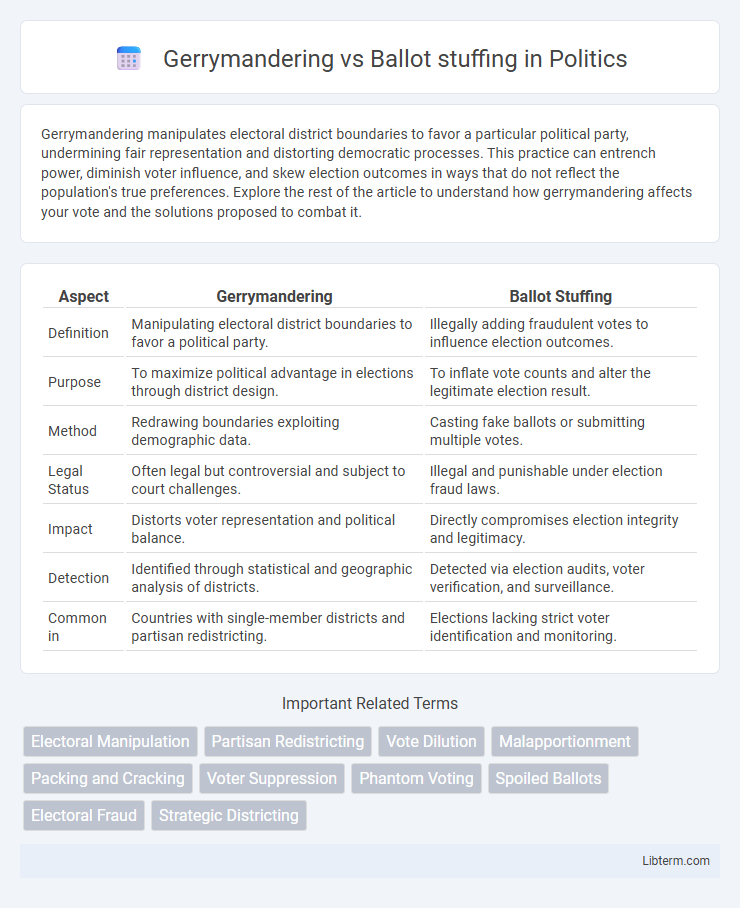Gerrymandering manipulates electoral district boundaries to favor a particular political party, undermining fair representation and distorting democratic processes. This practice can entrench power, diminish voter influence, and skew election outcomes in ways that do not reflect the population's true preferences. Explore the rest of the article to understand how gerrymandering affects your vote and the solutions proposed to combat it.
Table of Comparison
| Aspect | Gerrymandering | Ballot Stuffing |
|---|---|---|
| Definition | Manipulating electoral district boundaries to favor a political party. | Illegally adding fraudulent votes to influence election outcomes. |
| Purpose | To maximize political advantage in elections through district design. | To inflate vote counts and alter the legitimate election result. |
| Method | Redrawing boundaries exploiting demographic data. | Casting fake ballots or submitting multiple votes. |
| Legal Status | Often legal but controversial and subject to court challenges. | Illegal and punishable under election fraud laws. |
| Impact | Distorts voter representation and political balance. | Directly compromises election integrity and legitimacy. |
| Detection | Identified through statistical and geographic analysis of districts. | Detected via election audits, voter verification, and surveillance. |
| Common in | Countries with single-member districts and partisan redistricting. | Elections lacking strict voter identification and monitoring. |
Introduction to Gerrymandering and Ballot Stuffing
Gerrymandering manipulates electoral district boundaries to create an unfair advantage for a particular political party, often diluting the voting power of opposing groups. Ballot stuffing involves illegally adding multiple votes to skew election results, compromising the integrity of the voting process. Both tactics undermine democratic principles by distorting genuine voter representation and election outcomes.
Defining Gerrymandering: Manipulating District Boundaries
Gerrymandering involves manipulating electoral district boundaries to favor a particular political party or group, often resulting in unfair representation. This tactic distorts the voting power of certain demographics by concentrating or diluting their votes across districts, undermining democratic principles. Unlike ballot stuffing, which involves illegal vote tampering, gerrymandering legally exploits redistricting processes to influence election outcomes.
What is Ballot Stuffing? A Voter Fraud Tactic
Ballot stuffing is a voter fraud tactic involving the illegal addition of multiple ballots to inflate vote counts during elections, undermining the integrity of the democratic process. Unlike gerrymandering, which manipulates electoral district boundaries, ballot stuffing directly alters the vote tally by casting fraudulent votes. This practice compromises election fairness by distorting true voter intent and can lead to unlawful election outcomes.
Historical Overview of Electoral Manipulation
Gerrymandering, first identified in the early 19th century with the 1812 Massachusetts redistricting that favored Elbridge Gerry, involves the deliberate redrawing of electoral boundaries to benefit a political party. Ballot stuffing, historically documented during the late 19th and early 20th centuries in rapidly urbanizing areas, entails the illegal addition of votes to influence election outcomes. These manipulative strategies reflect longstanding challenges in maintaining electoral integrity across diverse democratic systems.
Methods and Techniques: Drawing Lines vs. Stuffing Boxes
Gerrymandering manipulates electoral boundaries by strategically drawing district lines to favor a particular party, often using techniques like cracking and packing to dilute or concentrate voter groups. Ballot stuffing involves the illegal addition of multiple ballots to a ballot box to artificially inflate vote counts, typically executed through physical ballot insertion or electronic vote manipulation. Both methods undermine democratic integrity but operate through spatial boundary adjustment versus direct vote count alteration.
Legal Framework: Laws Against Gerrymandering and Ballot Stuffing
Laws against gerrymandering focus on ensuring electoral district boundaries are drawn fairly to prevent manipulation that unfairly favors a political party, with key legislation like the Voting Rights Act and Supreme Court rulings shaping the legal framework. Ballot stuffing is explicitly prohibited under criminal statutes related to voter fraud, with strict penalties outlined in the Federal Election Campaign Act and various state election laws to safeguard ballot integrity. Both gerrymandering and ballot stuffing undermine democratic processes, prompting ongoing legal challenges and reforms aimed at preserving electoral fairness.
Impacts on Democratic Processes and Voter Trust
Gerrymandering distorts electoral representation by manipulating district boundaries to favor specific political parties, undermining the principle of fair competition in democratic processes. Ballot stuffing inflates vote counts fraudulently, compromising election integrity and eroding public confidence in voter outcomes. Both practices severely damage voter trust, leading to decreased political participation and skepticism towards democratic institutions.
Famous Cases: Gerrymandering vs Ballot Stuffing in History
The landmark case of *Baker v. Carr* (1962) exposed extreme gerrymandering in Tennessee, setting a precedent for judicial intervention in redistricting to prevent electoral manipulation. The 1948 Chicago mayoral election is a notorious example of ballot stuffing, where thousands of fraudulent votes inflated turnout, leading to public outrage and reforms in election oversight. Both cases highlight systemic vulnerabilities exploited through gerrymandering and ballot stuffing, shaping modern electoral integrity laws.
Detection and Prevention Strategies
Gerrymandering detection relies on advanced computational algorithms analyzing district boundaries for irregular shapes and partisan bias, while ballot stuffing is identified through statistical anomalies in voting patterns and surveillance data. Prevention strategies for gerrymandering involve independent redistricting commissions and transparent mapping processes, whereas ballot stuffing is mitigated by stringent voter ID laws, secure ballot designs, and real-time monitoring of polling stations. Both require robust legal frameworks and public oversight to ensure electoral integrity and fairness.
Future Solutions and Electoral Reforms
Future solutions to combat gerrymandering and ballot stuffing prioritize independent redistricting commissions and advanced blockchain voting systems to ensure transparency and fairness. Electoral reforms aim to implement non-partisan algorithms for district mapping and secure digital verification to prevent fraudulent voting activities. Strengthening oversight mechanisms and adopting multi-layered audit trails enhance the integrity of democratic processes worldwide.
Gerrymandering Infographic

 libterm.com
libterm.com